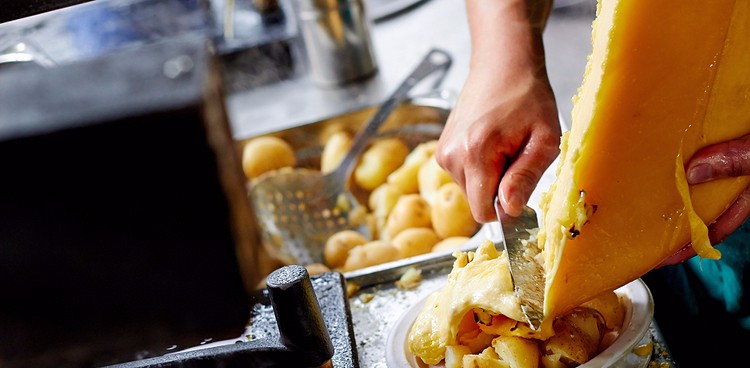
There are endless reasons to travel the world, but one always stands out: food. Get Cultured takes you on a journey through cheesy dishes from different cultures (heyo), exploring how they came to be, what makes them significant, where you can find the real deal, and how you can make your own.
Missed last week’s post on tiropita? Check it out!
Raclette, a completely socially acceptable excuse to buy a single-purpose grill specifically for melting cheese wheels, is a Swiss dish—really just melted cheese accompanied by whatever the eater likes best—that’s been around for centuries and has gained popularity in the US more recently.
How did the dish come to be? Let’s step into the shoes of some 13th-century Swiss herdsmen. After a long day’s work in the Alps, we settle down and build a fire, laying out the cheese wheels we’ve brought with us for sustenance. As we sit and chat, we suddenly notice that the cheese, close to the fire, is starting to melt. One of us jumps up and scrapes up the gooey cheese that has fallen onto a rock, determined not to waste a morsel of food. His eyes light up as he puts it in his mouth. It’s exquisite!
Some are adamant that it was grape harvesters, not herders, in the Valais vineyards that stumbled upon the delicacy, and some argue that the group was comprised of farmers. The consensus among all, however, is that somebody definitely discovered the dish in the Valais canton, and the world is definitely a better place for it. Less liquidy than fondue but softer than cheddar, raclette is often regarded as the ideal melting cheese.
“Raclette” refers to both the preparation of the dish and the cheese itself. The cheese is an uncooked, semifirm, washed-rind mountain cheese. Typically produced in 13-pound wheels with 12-inch diameters, the cheese is made from the milk of two breeds of cow, the Fribourgeois and the Ehringer, each of which lends a distinct flavor. The name “raclette” comes from the French verb racler, which means “to scrape,” chosen for the method of using a spatula-like knife to guide the melted layer of cheese off of the wheel and onto the plate.
Although our forefathers simply set the wheel down near an open flame, present-day turophiles prepare the dish with a bit more sophistication, generally using special raclette grills with considerable variation among them. There are three broad types of melting apparatuses—a flat grill to melt slices, a “quattro” to melt the top layer of a quarter-wheel, and a “demi” to do the same to a half-wheel.
A diehard traditionalist will tell you that there is no room for interpretation in a raclette meal—and, to be fair, the traditional way is hard to top. At its core, the meal is simple: the melted cheese is scraped onto a plate with boiled potatoes, cornichons, and sometimes meats. The less strict among us, though, can go rogue and add countless combinations of accompaniments. In fact, “raclette parties” are not uncommon—people gather around the raclette grill with an array of accompaniments on the table, and guests build their own plates of cheese, bread, veggies, and meat.

Image courtesy of margouillat photo via Shutterstock
So now comes the inevitable question: Where does one find this delectable mess of gooey cheese? The best option in its native territory is Raclette Stube in Zurich. The menu is fairly small, featuring not much more than several fondue options and a raclette meal, but what it lacks in variety it makes up for in quality. And raclette is supposed to be simple anyway, remember?
On this side of the Atlantic, we are lucky enough to have access to Raclette NYC, a unique, raclette-centric restaurant in the East Village whose menu is also relatively simple. The destination offers several toasties, raclettes, and tartines, and it attracts foodies from near and far. After sifting through several raclette photos, my own cursor is hovering over the “Add to Cart” button on some Amtrak tickets…
As for making your own, the flat style of raclette grill tends to be quite affordable, and a more elaborate model might be worth a splurge. You may have to go beyond the supermarket to find raclette cheese, but it’s pretty accessible at specialty cheese shops. And for raclette-on-the-go, try this ridiculously decadent grilled cheese sandwich.
Check out next week’s post on India’s cheesy version of creamed spinach, saag paneer!
Feature photo courtesy of AmbientShoot via Shutterstock




